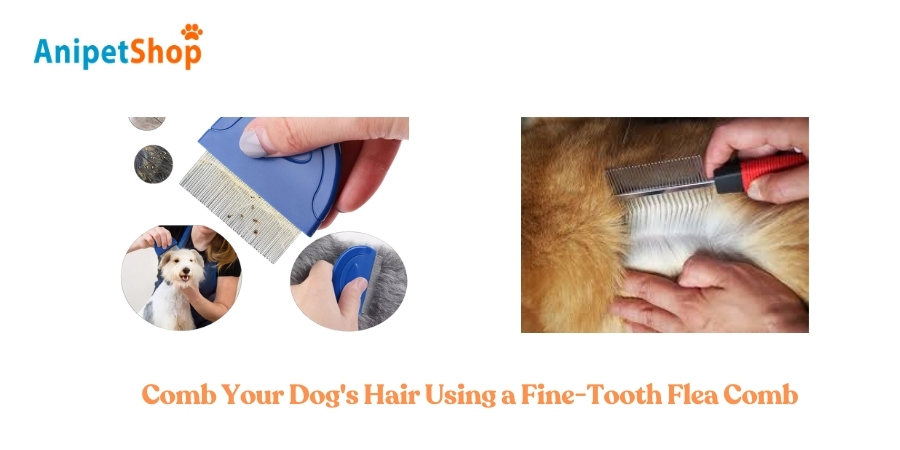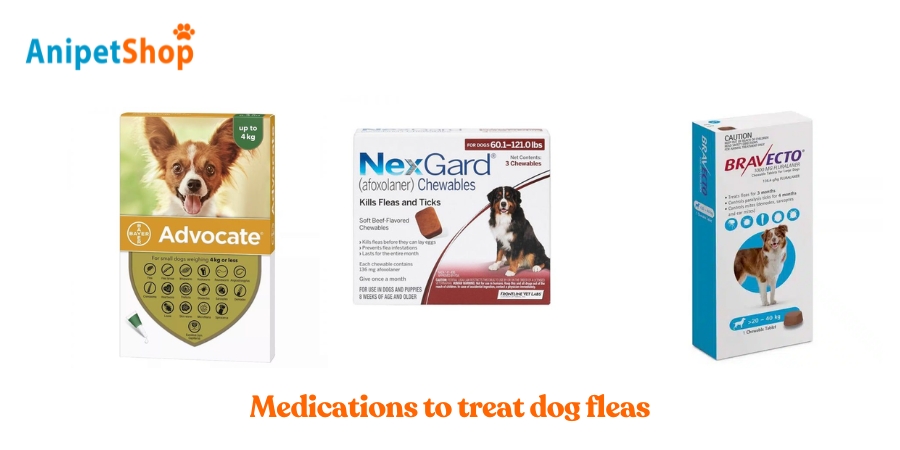How to Get Rid of Dog Fleas
Fleas can cause skin irritation, allergic reactions, and even serious health issues for pets if not treated. These pests can survive for months in your home’s carpets, bedding, and furniture, so it’s essential to tackle them on multiple fronts. This guide provides key steps to eliminate fleas effectively, from bathing and combing your pet to using the best flea treatments, such as oral and topical medications. We’ll also cover natural repellents like apple cider vinegar, home-cleaning strategies, and when to consult a vet for persistent infestations or complications. With these steps, you can keep both your pet and home flea-free.
By following these steps, you can create a flea-free environment and ensure your pet stays comfortable, healthy, and itch-free. Whether you’re dealing with an active flea problem or looking to prevent future infestations, this guide provides you with all the information you need to protect your furry friend.

Give Your Dog a Bath with Shampoo
One of the most effective first steps in getting rid of fleas is giving your dog a bath. Using lukewarm water alone, or with a mild soap, can help remove fleas from your dog’s coat and skin. A gentle dish soap may also aid in drowning adult fleas. If you’re considering a flea shampoo or other similar product, consult your veterinarian beforehand. Flea shampoos can strip essential oils from your dog’s fur, potentially leading to dry, irritated skin. Always review the ingredient list to ensure the shampoo is safe to use with any flea and tick preventatives your dog is currently using. Avoid bathing your pet for at least 24 hours before or after applying a topical flea and tick treatment.
Here’s a streamlined guide to safely and effectively bathe your dog to help eliminate fleas:
- Choose Lukewarm Water with Mild Soap or Flea Shampoo: Bathe your dog using lukewarm water with either a mild soap, like pet-safe dish soap, to help remove fleas, or a flea-specific shampoo suited to your dog’s age and weight to kill fleas on contact. Avoid harsh chemicals that may irritate sensitive skin.
- Prepare the Bathing Area: Gather essentials like shampoo, towels, a flea comb, and treats to keep your dog calm, and protect their eyes and ears from water and shampoo using a damp cloth or cotton balls.
- Wet Your Dog’s Coat Thoroughly: Use lukewarm water to soak your dog’s coat fully, as hot water can irritate their skin and make fleas burrow deeper.
- Apply Mild Soap or Flea Shampoo: Begin at the neck and work downwards, massaging the mild soap or flea shampoo into your dog’s coat. Avoid the head area initially to prevent fleas from migrating there. Let the product sit for 5–10 minutes (or as directed) to ensure it effectively targets the fleas.
- Rinse Thoroughly: Rinse until the water runs clear to remove all mild soap or shampoo, starting from the top and working down to prevent drying out the skin.
- Dry Your Dog: Use a towel or a low-heat dryer to gently dry your dog, and then use a flea comb to remove any remaining fleas, focusing on areas like the neck, belly, and tail.
If your pet is allergic to fleas (often referred to by your vet as flea allergy dermatitis), its skin may be particularly sensitive. The same applies if your pet has any open wounds or raw spots. Certain chemicals in flea products can aggravate irritation and potentially worsen infections.
While giving your pet a bath can be beneficial, it’s not always necessary. If you’re concerned about how your pet will respond, it’s perfectly fine to skip this step. It’s important not to bathe your pet excessively. Consult your veterinarian to determine the best bathing frequency for your pet. Some pets may require daily baths for severe infestations, while others may only need weekly baths. The frequency may also vary depending on the type of shampoo used.
Comb Your Dog’s Hair Using a Fine-Tooth Flea Comb
To check if your pet has fleas, a fine-toothed flea comb is a simple and effective tool. Start by grooming your pet over a white surface, such as a piece of kitchen paper. As you comb, any fleas or flea droppings (commonly called “flea dirt”) will fall onto the paper, making them easier to spot. Flea dirt appears as tiny, dark brown or black specks, resembling pepper flakes. Using a flea comb can also help remove not only adult fleas but also their eggs, helping to control infestations.
Steps to Remove Fleas Using a Flea Comb:
- Prepare a Soapy Water Mixture: Before you start combing, fill a container with water mixed with a few drops of dish soap. This soapy water traps and kills fleas once they’re removed from your pet’s fur, preventing them from jumping back.
- Use a Fine-Toothed Flea Comb: A flea comb has closely spaced teeth that help capture fleas, flea dirt, and eggs without pulling your pet’s fur. Part your pet’s coat with the comb or your fingers, focusing on areas like the neck and tail, where fleas commonly hide and feed.
- Check for Fleas and Flea Dirt: Hold the flea comb over a white surface (e.g., a paper towel or kitchen paper) while combing to catch any fleas or flea dirt. To confirm if it’s flea dirt, add a drop of water; flea droppings will turn reddish-brown when wet, indicating the presence of fleas.
- Comb Thoroughly and Dispose of Fleas: Move methodically through your pet’s coat, placing any captured fleas directly into the soapy water to kill them. Combing outdoors can prevent fleas and eggs from spreading in your home.
- Daily Flea Checks for Infestations: During a flea infestation, daily combing can help reduce flea populations and prevent eggs from hatching. Set reminders to perform these checks and clean your pet’s bedding regularly.
Ensure your dog is calm and comfortable before you start. Gently comb through their fur, starting from the head and moving towards the tail. Focus on areas where fleas often gather, like the neck, behind the ears, and the base of the tail. If your dog has long or thick fur, part the hair to reach the skin more effectively.
Regular grooming with a flea comb can be a practical part of flea prevention and early detection, especially when combined with vet-recommended flea control methods.

Treat the Fleas
To effectively combat fleas, it’s crucial to treat both your dog and your home, as fleas can survive in the environment for months without a host. Here’s how to manage flea treatment at home:
- Use Preventative Flea Treatments: Regularly applying flea treatments for your dog helps prevent infestations. Consult your vet to select the most effective product for your dog’s specific needs.
- Act Quickly on Sightings: If you notice fleas on your dog, treat them promptly to prevent the spread of diseases and parasites, such as tapeworms. Consider deworming your dog as part of the treatment.
- Clean Regularly: Wash your dog’s bedding frequently, and vacuum furniture, floors, and skirting boards thoroughly to eliminate fleas in various stages of their life cycle. Always dispose of the vacuum bag or empty the canister after each use to prevent flea eggs and larvae from developing.
- Maintain a Year-Round Routine: For homes with central heating, fleas can remain active all year, so regular treatment for both your dog and home may be necessary to keep them at bay.
- Use Vet-Approved Treatments: Only apply flea treatments specifically recommended for your dog, ideally as prescribed by your veterinarian, as products for one species may not be safe or effective for another.
Use Flea Medications
There are several types of flea medications designed to kill fleas on your dog. Some also offer combined protection against other parasites like ticks, heartworm, hookworm, and tapeworm. Your vet can recommend the best option based on your dog’s health, size, and the severity of the flea infestation.

Oral Flea Medications
Oral flea prevention is highly effective, acting quickly to kill fleas within 30 minutes to a few hours. Dr. Howe recommends monthly oral flea preventatives that also protect against ticks, such as:
These products provide both flea and tick protection, reducing the risk of tick-borne illnesses as well. For immediate, over-the-counter relief in emergencies (like treating a stray dog), options like Capstar® and Advantus® can kill adult fleas quickly but require monthly prevention for long-term control.
Topical Flea Medications
Topical flea and tick preventions are highly effective, though their liquid form can be challenging to apply and may take 12 to 48 hours to start killing fleas. These treatments are typically applied to the back of your dog’s neck to prevent them from ingesting the medication while it’s still wet. It’s crucial to let all topical medications dry completely before allowing your dog to interact with other pets or small children in the household. The medication spreads through the dog’s skin oils, offering month-long protection. These easy-to-use solutions target adult fleas, larvae, and eggs, ensuring comprehensive protection against infestations. Some topical treatments, like Frontline Plus®, are available over-the-counter, while prescription options such as Revolution®, Advantage Multi®, and Bravecto® provide additional parasite protection.
Natural Flea Medications
Avoid flea treatments marketed as “natural” or “homeopathic.” These products are not proven to effectively repel or kill fleas, and some can even be harmful to dogs, worsening irritated or itchy skin. To safely protect your pet, opt for FDA-approved flea medications.
Currently, no natural products have been shown to reliably prevent fleas on dogs. Some so-called natural treatments include ingredients like garlic, which is toxic to dogs and can be dangerous if ingested.
For those looking for a more naturally derived option, certain flea medications like Simparica® are based on a natural molecule found in soil. If you’re interested in such alternatives, ask your veterinarian if Simparica is suitable for your dog.
Flea Shampoos and Sprays
Flea shampoos and sprays can offer fast relief for active flea infestations. Medicated shampoos kill fleas on contact, but they do not provide lasting protection, so they are best used alongside prescription oral or topical treatments. While medicated flea shampoos are effective, a soothing oatmeal shampoo can also help relieve itching without drying the skin.
Combining an oral or topical medication with a flea shampoo can provide both immediate relief and long-term prevention. Ask your vet for the best combination to ensure comprehensive protection and comfort for your pet.
Use an Apple Cider Vinegar Spray
Apple cider vinegar is often used as a natural flea repellent for pets, though it doesn’t kill fleas directly. The strong smell and acidic taste deter fleas, making them less likely to stay on your pet. Here’s a more in-depth look at how to safely and effectively use apple cider vinegar to help manage fleas on your pet:
How to Create an Apple Cider Vinegar Flea Spray:
- Prepare the Solution: Mix one part apple cider vinegar with one part water. You can adjust the strength slightly if needed, but keep it mild to avoid skin irritation. Use filtered or distilled water to reduce impurities.
- Use a Spray Bottle: Pour the diluted solution into a clean spray bottle for easy application. A fine mist will help distribute the solution evenly over your pet’s fur without soaking them.
- Apply Carefully: Spray lightly onto your pet’s coat, focusing on areas where fleas commonly hide, such as around the neck, behind the ears, along the spine, and near the base of the tail. Avoid spraying near your pet’s eyes, nose, and mouth, as the acidity may cause discomfort.
- Alternative Application Method: If your pet dislikes being sprayed, dip a grooming brush or cloth into the vinegar solution, then gently brush or wipe it through their coat. This method may be less stressful for pets that are sensitive to sprays and still allows you to apply the vinegar solution effectively.
- Let It Dry Naturally: Allow the solution to air dry on your pet’s coat. Avoid rinsing it off, as the residual smell helps repel fleas. The scent will fade for humans, but it will still be detectable to fleas.

Perform Regular Flea Checks
If your pet has previously dealt with fleas, perform weekly checks using a fine-toothed flea comb, focusing on areas like the neck, base of the tail, and belly, where fleas tend to congregate. Comb over a white paper towel to make fleas or flea dirt (tiny black specks) easier to spot. Regular combing can help you catch fleas early and prevent larger infestations
If your pet has a history of flea issues, it’s crucial to incorporate regular flea inspections into your care routine. These checks should be performed at least once a week, ideally using a fine-toothed flea comb specifically designed for this purpose. Focus your attention on high-risk areas, such as the neck, belly, and the base of the tail—prime locations where fleas tend to hide and thrive.
To make detection easier, comb your pet over a white surface, like a paper towel or sheet, which will help reveal any adult fleas or “flea dirt” (small black specks of flea feces). If you’re unsure, place any collected material onto a damp paper towel; flea dirt will dissolve into reddish-brown streaks due to the presence of digested blood.
Beyond catching fleas early, this routine also serves as an opportunity to monitor your pet’s skin for signs of irritation or allergic reactions caused by flea bites. Early intervention can prevent infestations from worsening and reduce the chances of secondary issues like dermatitis.
By making flea checks a consistent habit, you not only protect your pet’s comfort but also safeguard your home from potential outbreaks. Pair this practice with year-round flea prevention measures for comprehensive protection.
Allow Self-Grooming
Self-grooming can be a natural response to flea discomfort. Cats, in particular, increase grooming when they have fleas, which helps them remove fleas and flea dirt. Dogs may also groom or scratch more if fleas are present. While some increased grooming is normal, excessive licking, biting, or scratching can indicate a problem. If your pet begins to lose hair, or you notice inflamed, red, or bloody skin, contact your veterinarian, as these symptoms may point to a flea allergy, infection, or another skin condition that needs attention.
Fleas don’t just live on pets; they can survive in carpets, pet bedding, and other soft surfaces in your home, where they lay eggs and develop. Although fleas jump onto pets (and sometimes people) for feeding, they usually leave after a meal. Be diligent about cleaning, vacuuming, and washing your pet’s bedding weekly in hot water to disrupt the flea lifecycle and reduce the chance of reinfestation.
Even if you don’t spot fleas, your pet could still have been bitten. Some pets are highly sensitive to flea bites, which can lead to itching, skin irritation, or even a skin infection. If you’re uncertain whether fleas are the culprit, a veterinarian can confirm the diagnosis and suggest the most effective treatment.
See a Veterinarian
While flea infestations aren’t typically an emergency, some cases call for immediate veterinary attention. Prescription flea treatments, like oral medications, topicals, or collars, are often the most effective and safe options for tackling fleas. Contact your vet promptly if you notice any of the following symptoms in your pet:
- Lethargy: Severe flea infestations can lead to anemia, particularly in small or young animals, causing them to feel weak or sluggish.
- Unexpected Weight Loss: A large flea population can cause weight loss in pets due to the blood loss associated with feeding fleas.
- Scooting or Dragging: If your pet frequently scoots across the floor, this may be a sign of tapeworms, which can be transmitted by fleas.
- Tapeworm Segments in Stool: Fleas can carry tapeworm larvae, and if your pet ingests an infected flea, it can lead to tapeworms. Tapeworm segments in stool look like small, rice-like grains and indicate an infestation.
- Pale Gums: Pale gums can be a sign of anemia, often caused by flea infestations in severe cases. Anemic pets may also show signs of weakness, fatigue, or increased thirst.
Seeing a vet will not only address these symptoms but also provide you with a safe and effective flea treatment plan, including guidance on preventive care. Flea prevention is essential, and regular veterinary checkups can help ensure your pet’s ongoing protection against fleas and the complications they bring.
Why you need to get rid of fleas quickly?
Fleas pose significant discomfort to pets, rapidly multiply, and are capable of spreading diseases and parasites, making swift eradication essential. These pests can also bite humans, leading to itchy welts, and are known carriers of diseases such as typhus, plague, and cat scratch disease. Fleas can transmit tapeworms to both people and animals and infect cats with Bartonella, the bacteria responsible for cat scratch disease, which can be passed on to humans. For animals, flea infestations can result in severe skin infections, hair loss, scabs, and sores. In extreme cases, particularly with smaller animals like puppies and kittens, the blood loss caused by fleas can lead to anemia and potentially death.
Prompt intervention is critical when dealing with fleas due to their fast reproductive cycle and the considerable health risks they pose. A single flea can lay up to 50 eggs daily, with these eggs hatching within days under ideal conditions. This rapid growth means that even a small infestation can quickly escalate into a significant problem.
Effectively addressing a flea infestation requires immediate, comprehensive action. A well-rounded approach, including pet treatment, thorough home cleaning, and maintaining yard hygiene, is vital for preventing re-infestation. Regularly cleaning bedding, vacuuming furniture, floors, and baseboards are crucial to disrupting the flea lifecycle at every stage. By combining these strategies, you can significantly decrease the chances of fleas returning and protect your home and pets from the discomfort and health risks associated with these parasites.
See More: How to Get Rid of Fleas in Your House and Yard
How long does it take to get rid of fleas?
The duration required to eliminate a flea infestation can vary considerably depending on the severity of the problem and the thoroughness of the treatment methods employed. In mild cases, it may take as little as a few days to a week to see notable improvement. However, more severe infestations may require several weeks of diligent effort and multiple treatments to fully eradicate the pests.
Effective flea control typically involves a multipronged approach, addressing both the living environment and any infested pets. Initial treatments, such as vacuuming, washing bedding, and using insecticides or natural remedies, can reduce the adult flea population quickly.
Adult fleas will be eliminated within a few days, but it’s crucial to avoid vacuuming, sweeping, or washing the floor for at least two weeks after treatment. This is because flea eggs will continue to hatch during this period. As the eggs hatch and mature, you may notice fleas reappearing 10 to 14 days after treatment. This is a normal occurrence, and as long as the insecticide remains undisturbed, it will continue to eliminate the fleas. Therefore, it’s essential to avoid cleaning that could remove the insecticide.
Patience and consistency are key. While initial measures may yield quick results, complete eradication often requires ongoing vigilance. Homeowners should be prepared for a series of treatments over several weeks.
Managing fleas effectively involves a combination of regular bathing, combing, home cleaning, and vet-approved flea treatments. While natural remedies like apple cider vinegar may help repel fleas temporarily, oral or topical medications provide lasting protection. Regular veterinary check-ups ensure that your dog receives the safest, most effective flea control.
By treating both your dog and your home, you can prevent infestations, protect against flea-borne illnesses, and keep your pet comfortable and healthy. Flea prevention requires ongoing care, but with consistent effort, you can maintain a happy, flea-free environment for your pet.
Lily Watson is an author specializing in veterinary care in Australia. With a profound passion for animal welfare and a solid foundation in veterinary science, Lily has dedicated herself to disseminating valuable knowledge and information for both pet owners and professionals in this field.

